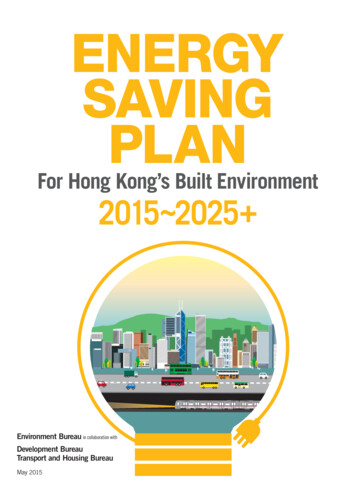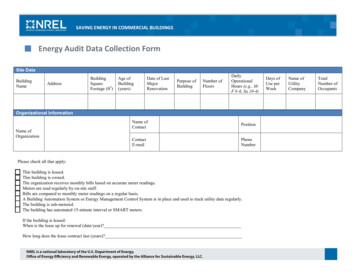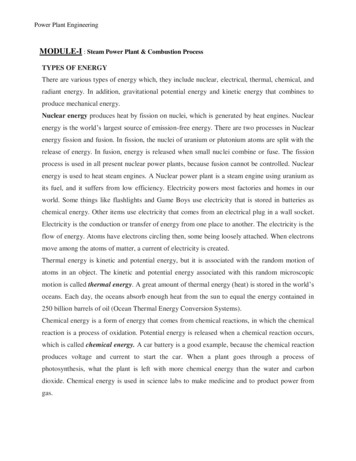
Transcription
ENERGYSAVINGPLANFor Hong Kong’s Built Environment2015 2025 Environment Bureau in collaboration withDevelopment BureauTransport and Housing BureauMay 20151
CONTENTSPAGE1Message from the Chief Executive2Special Messages from Principal Officials4Preface5Summary of Energy Saving Plan forHong Kong 2015 2025 7Executive Summary11 1Introduction24 2Foundation for Energy Saving38 3Energy Wise Green Buildings57 4Energy and Transportation63 5Setting Energy Saving Targets71Abbreviations
MESSAGE FROM THE CHIEF EXECUTIVESaving energy should be a matter of course for Hong Kong. This documentlays out our energy-saving policy, strategy and targets. The Hong Kong SARGovernment has taken stock of past efforts and charted a path that coversbuildings and transportation, the two most important areas in which Hong Kong can doto save energy significantly. We have also detailed the gaps and challenges with a view toengaging the community to discuss on best way forward.In the past decade, we have reduced electricity use in our government buildings aloneby nearly 15%. In my 2015 Policy Address, I pledged a new target of reducing anadditional 5% electricity consumption in government buildings over the next five years.We have also encouraged all major new government buildings and public housing toachieve a higher green building standard.In the end, of course, the community plays an indispensable role when it comes toenergy conservation. I hope private-sector building owners and managers will tooset targets to reduce their energy consumption comparable to or even exceedingGovernment targets, and to promote green building design and management as well.I also encourage the transportation sector to save energy.Indeed, everyone can reduce energy consumption by making modest changes to theirdaily lives. Being ‘Energy Aware’ and ‘Energy Wise’ will help Hong Kong become moreeconomically competitive. No less important, it will make Hong Kong an even better cityto live, work and raise our families in. I call on everyone to play your part.C Y LeungChief ExecutiveHong Kong Special Administrative Region1
SPECIAL MESSAGES FROM PRINCIPAL OFFICIALSI am pleased to witness the publication of this Energy Saving Plan which sets for Hong Kong ourown target for reducing energy intensity by 40% by 2025. It shows our commitment toenvironmental protection, and demonstrates the progressiveness of Hong Kong in tackling theglobal problem of climate change. I look forward to the concerted efforts of the Government andthe community in promoting a healthy, liveable and sustainable environment in Hong Kong.Carrie LamChief Secretary for AdministrationEnergy saving is one of the best examples of how we can save money, be morecompetitive economically, as well as improve local air quality and contribute to reducingglobal carbon emission. I look forward to the outcome of the Government’s dialogueplatform with stakeholders on what may be the least-cost-highest-gains energy savingopportunities in Hong Kong.John C TsangFinancial SecretaryThe legal framework has put in place the energy efficiency standards for buildings and appliances.However, there is no reason why we should not try to do even better. It is our shared responsibility tocombat the negative effect of climate change. For the sake of ourselves and our future generations,let’s strive to fulfil this duty by (among others) saving energy.Rimsky Yuen, SCSecretary for JusticeOur commitment to sustainable development is unquestionable as reflected in our vision to position Hong Kongas Asia’s World City and make it a better place to live and work in. I am glad to join hands with the EnvironmentBureau and the Transport and Housing Bureau to pursue our shared vision to promote energy saving. I also lookforward to the active participation of our stakeholders in the construction and buildings sector in achieving andperhaps even exceeding the new energy intensity reduction target of 40% by 2025.Paul ChanSecretary for DevelopmentThe ever-growing demand for goods and services brought about by the increasing population requires us to seriously reviewour lifestyle to avoid depletion of valuable resources such as fossil fuels and clean air. As housing and transport constitutemajor sources of energy consumption, we have been striving to integrate energy saving features into public housingdevelopments, as well as to expand and improve public transport. Such efforts can help save energy without compromising thelevel of comfort and convenience on the part of the users. But energy saving cannot be made possible by infrastructuresupport alone. It has to be practised. I hope the Energy Saving Plan will help inspire news ideas on how we may embraceenergy saving in our daily lives.Professor Anthony CheungSecretary for Transport and HousingThe cornerstone of success in achieving the new energy intensity reduction target is communityparticipation, which has been enunciated in the Energy Saving Plan. Our energy saving plan shouldstart right at home, and I appeal to your support for taking action to cut down on unnecessary energyconsumption in your family.Tsang Tak-singSecretary for Home AffairsEnergy saving should no doubt be our common goal, not just for cost concern but also for ouraspiration to make Hong Kong a better place to live. Let’s join hands to promote sustainable use ofenergy so that we and our future generations will be able to thrive in a clean and green environment.Raymond TamSecretary for Constitutional and Mainland Affairs2
SPECIAL MESSAGES FROM PRINCIPAL OFFICIALSOur economy has been powered by about 230,000 terajoule of energy annually. It isour duty to manage our energy consumption, so that we can reduce energy use and savemore resources. We in the Government will continue to be a prudent manager of energyconsumption, in the same way as we exercise prudent financial control.Professor KC ChanSecretary for Financial Services and the TreasuryI am gratified to see the various initiatives both within and outside the Government to encourage thecommunity to conserve energy. A number of civic-spirited corporations have chosen to channel the savings fromtheir electricity bills to care for the needy. This is a win-win formula as it can motivate all of us not only to care forthe environment but also assist the grassroots and underprivileged. I hope that we can build on such heartwarming and commendable efforts.Matthew Cheung Kin-chungSecretary for Labour and WelfareA sustainable future for Hong Kong would require a harmonious balance between economic development andconservation of the environment. It is possible to achieve such balance by pursuing initiatives that can helppromote economic development and environmental protection at the same time. I would like to encourage ourstakeholders to actively participate in our energy saving efforts by conserving energy, and capitalising on thebusiness opportunities brought about by the need for more energy management services.Gregory SoSecretary for Commerce and Economic DevelopmentAs the premises of our disciplinary forces operate round the clock, it is imperative for usto use energy wisely. We have been striving to minimise energy consumption byundertaking energy saving projects for our police stations, fire stations as well ascorrectional institutions. Our colleagues will, on the basis of our past experience andachievements, continue to explore new energy saving opportunities.TK Lai Secretary for SecurityEnergy saving is an important concept for our future generations to enjoy a sustainable environment. This is truly a personalresponsibility and obligation for all educated individuals in our society. Cultivating this basic value and lifestyle should beststart in the formative age of our students. It is therefore advisable to instil energy-saving attitude and habits among primaryand secondary school students. I am glad to note that many schools have already taken initiatives in such work. To achieve thegoal, the Education Bureau will continue to enhance efforts in collaboration with the Environment Bureau and schools.Eddie NgSecretary for EducationTo save energy and combat the negative effects of climate change, the Government hasbeen taking the lead to reduce electricity consumption so as to set a good example for thecommunity. I will call upon all Government colleagues to further enhance their energysaving practices, and to spread this energy saving culture to their families and friends.Paul TangSecretary for the Civil ServiceWe are committed to building a healthy society, and cutting down on energy consumption will certainly contribute to betterair quality, and hence human health and well-being. Our hospitals managed by the Hospital Authority have long been engagedin energy saving efforts, including the adoption of energy saving features and good housekeeping measures. I would encourageall hospitals in Hong Kong to set for themselves ambitious energy saving targets in order to reduce greenhouse gas emissions,improve air quality and promote the health of the population.Dr WM KoSecretary for Food and Health3
PREFACEBe Energy Aware & Energy WiseFrom air-conditioning to a myriad of mobile communication devices, waterheating to mobility, modern societies depend on energy in nearly everyaspect of life. Energy is essential for us at home, at work, on the road, atsea and in the air. Indeed, technology has made our need for instant energy socommon place that we hardly notice it at all.Fossil fuel still powers much of the world, including Hong Kong, but thecombustion process also produces large quantities of waste in the form of airpollutant emissions and greenhouse gases. By conserving energy and using itmore efficiently, we will waste less, pollute less and reduce the impact on analready overstressed environment.Hong Kong has a high-density, high-rise lifestyle. As one of the world’s majorfinancial and commercial centres, where much of our activities take place in tallbuildings, we use a substantial amount of energy to power our high GDP economy.Thus, energy saving, especially with respect to buildings and transportation, is ourkey effort in Hong Kong. Our energy-efficient transport system due to our highurban density has been internationally recognised since the 1980s, while HongKong’s green building movement started in earnest in the 1990s.In the coming decades, world demand for energy will rise as global populationincreases. Yet, at the same time there will be increasing constraints on how muchfossil fuel the world can safely burn in light of the need to improve air quality, andalso what science tells us about the vulnerability of climate disruptions to higherglobal levels of greenhouse gases. Before the world can switch away from burningever more fossil fuel, Hong Kong too should play a part in promoting energy saving.Indeed, each one of us can be more ‘Energy Aware’, especially saving electricityin buildings, so that being ‘Energy Wise’ becomes second nature to Hong Kongpeople. I hope this document will help our residents to understand energy issuesbetter and stimulate all of us to take wiser action.K S WongSecretary for the EnvironmentMay 20154
SUMMARY OF ENERGY SAVING PLANFOR HONG KONG 2015 2025 TARGETYear2025ENERGY INTENSITYGOVERNMENT BUILDINGSAND PUBLIC HOUSINGHong Kong to achieve energygyintensity reduction by 40 %by 2025 using 2005 as thebasePLATINUMBe “Energy Aware””and “Energy Wise””POLICY New government buildingswith construction floorarea of 5,000 m2 withcentral air-conditioning or 10,000m2 to achieve atleast BEAM Plus Gold; andGor b OLDe t ter New public housing toachieve at least BEAM PlusGold readySTRATEGYTo drive energy savingthrough a combinationof educational,social, economic andregulatory means,especially for buildingsand inhabitants tobecome highly energyefficient by 2025PUBLIC SECTORGovernment and publicsector developmentagencies to lead byexample and accelerateconditions for changePRIVATE SECTORFocus on energy savingin new and existingprivate sector buildings tocapture potential TIONCHANGEREGULATORYCollaborate with energyand built environmentstakeholders to enablethe ‘Energy s,Facility ManagersSuppliers andManufacturersUtilitiesArchitects, Engineers,Contractors etc.SOCIALRelative Energy Saving PrioritiesCommercial &Instituitional BuildingsResidentialBuildingsBuilding design and structure1Appliances inhabitants choose to useInhabitants’ behaviour2Inhabitants’ behaviourAppliances inhabitants choose to use3Building design and structure5
SUMMARY OF ENERGY SAVING PLANFOR HONG KONG 2015 2025 KEY ACTIONS1 Lead the energy saving and green buildingtransformation through governmentbuildings, public housing and public sectordevelopment (see targets)6 Update schools and publiceducation programmes2 Government buildings to achieve 5%electricity reduction target by 2020 (2014 asbase); further reduction from 2020-2025 tobe determined in 2019-20ECONOMICSEDUCATION7 Strengthen governmentdepartmental energy saving effortsthrough appointing Green Managersand Energy Wardens; andencourage public sector institutionsto save energy6,400(about 1/7)buildingsparticipatedin BEEFSAlready in existence Energy saving in physicscurriculum; Various secondary school materials; Energy Efficiency Centre at HongKong Science Museum; Energy websiteAlready in existence 1/7th of buildings in Hong Kong (about 6,400 buildings)participated in the 450 million Building Energy EfficiencyFund Scheme (BEEFS) programme; district cooling at Kai Tak; Gross Floor Area (GFA) concessions for private-sector greenbuilding projects; and approximately 100 million power companies’ EcoBuilding Fund (CLP Power Hong Kong (CLP)) and PowerSmart Fund (The Hongkong Electric Company Limited(HEC)) for energy saving 2014-18Periodic review, expand and/or tightenrelevant energy-related standards:8 Support community campaigns viagovernment funding schemes3 Buildings Energy Efficiency Ordinance(BEEO);9 Collaborate with large energycommercial users to develop sectorspecific campaigns4 Building (Energy Efficiency)Regulation, (B(EE)R); andREGULATORY5 Energy Efficiency (Labelling ofProducts) Ordinance (EELPO)Already in existenceBEEO, B(EE)R and EELPOSOCIAL10 Secretary for the Environment toengage built environment leadersto accelerate green buildingadoption in the private sectorAlready in existence Thousands of Energy SavingCharter partners since 2005; Partnership with stock exchangeon carbon footprint repositoryand Environmental, Social andGovernance reporting for listedcompanies66
EXECUTIVE SUMMARYTo become ‘Energy Aware’ and‘Energy Wise’, energy saving willneed to have a ‘centre stage’role not only in government policybut also in how businesses operateand how individuals live. Hong Kong’senergy saving policy focuses on drivingenergy saving through a combinationof educational, social, economicand regulatory means, especially forbuildings and inhabitants to becomehighly energy efficient by 2025.Hong Kong’s energysaving focusHong Kong has a four-pronged strategyto save energy. They are focussed ongovernment taking the lead; improvingbuilding energy efficiency for both newand existing buildings because buildingsconsume 90% of the city’s electricityusage; enabling companies, institutionsand residents to make energy efficiencychoices when they invest in electricalappliances and vehicles; and promotingenergy saving practices and lifestyle forThis document provides the backgroundthe people of Hong Kong.to energy saving in Hong Kong and alsowhere opportunities lie. We will strive toachieve an energy intensity reductionChronology of effortstarget for Hong Kong as a whole of40% by 2025 using 2005 as the base. The Government has had a twodecade long attempt to build aTo achieve this, the community mustfoundation for Hong Kong to achievecontribute by changing their behaviour,as regulatory action alone is not enough. higher energy savings, wheregovernment taking the lead has beenThe proposed dialogue platform withcrucial. The chronology of action sincestakeholders seeks to further expedite1993 noted in Chapter 2 is extensive.green building adoption in the privatesector, which is critical to achieving thisOur efforts over the years, when seentarget. Indeed, only if the communitytogether, produced solid results. Sincecan change its behaviour, can Hongthe 1990s, the Government’s effortKong look forward to an even moreto collaborate with built environmentambitious outcome.professionals to promote green buildinghas helped start a whole movementin Hong Kong. We are grateful to theHong Kong Green Building Council(HKGBC) for the part it played.7
EXECUTIVE SUMMARYSuccesses to dateOur success includes:1 2 3 Laying the legislative foundation tocontinuously save energy throughthe B(EE)R; BEEO and EELPO,which together target energy use inbuildings;Aiming to achieve BEAM Plus Goldfor all major government buildingsand committing to achieve BEAMPlus Gold ready or better ratingby Hong Kong Housing Authority(HKHA) for new public housingdevelopments;Reducing energy consumptionsuccessfully in government buildingsfrom two rounds of effort from 200307 and 2009-14 by over 6% and 5%respectively, and setting a new targetto reduce yet another 5% from 201520 using 2013-14 as the base; Investing in energy saving systemsin major public infrastructure,such as district cooling in Kai TakDevelopment;6 Providing 450 million to implementBEEFS, which represents one of thelargest government-funded energysaving schemes in the world; 1/7thof the private sector buildings inHong Kong (about 6,400 buildings)participated in the BEEFS;7 Enabling the power companies toprovide the estimated 100 million tosupport energy saving projects from2014 for 5 years;88 9a green building4 Promulgatingperformance framework forRaising overall public awareness tosave energy; and mobilising a largenumber of companies, schools andinstitutions to save energy through arange of continuous campaigns since2005;government buildings since 2009;5 Promoting green building in publicsector developments, especiallyfor Hong Kong Housing Society(HKHS) projects and Urban RenewalAuthority (URA); Collaborating with built environmentprofessionals through institutionalsetup and systematic strategies topromote green building, includingprofessional development, awardsand research and development(R&D).108
EXECUTIVE SUMMARYGaps to be filledGoing forwardThere are gaps that still need to befilled, especially in relation to buildingsin the private sector, such as the onesbelow, but it must be emphasisedthat the public must also take on theresponsibility to act more decisively tosave energy in the coming years. Onthe part of Government, we will do thefollowing:A. Promoting energy wise buildingsHaving laid a foundation for energywise green building in Hong Kong, thenext step is to articulate a clear path onachieving further gains for existing andnew buildings.1 Capacity BuildingBuilding greater capacity amongprofessionals to provide a wide rangeof energy saving and green buildingservices as demand for them grows;2 Social MobilisationWidening and deepening socialmobilisation campaigns with targetedsectors, such as commercial buildingoperators to achieve higher energysaving results;3 Energy DataImproving the provision of energy dataso that they can be more readily usedby the public; collecting and compilingbuilding energy-related data so thatthe Government and built environmentsector can consider further energysaving measures;4 Existing BuildingGetting building owners of existingbuildings in the private sector toadopt energy saving installationsand retrofits, and also to adoptenergy saving and green buildingmanagement.B. Mobilising stakeholdersThe power suppliers for electricity andtown gas are key stakeholders in energysaving. Commercial and residentialbuilding owners are a large and diversegroup of stakeholders, whose supportis critical to promoting energy wisegreen buildings. Many issues need tobe deliberated upon and mobilised bythem through concerted effort. Majorcommercial stakeholders in the transportsector are already focussing on energyefficiency to a great extent becauseenergy cost is their largest expenditureitem outside staff cost. However, gainscan still be made by the Governmentcollaborating with them on promotingenergy saving practices, and at thesame time reducing air pollution andgreenhouse gas emissions.C. Community taking responsiblityFor Hong Kong to save energyas a whole, the people must takeresponsibility. While we will step upcollaboration with relevant stakeholdersto equip energy consumers in all sectorswith better skills and the readinessto do more with less, ultimately, thecommunity needs to take collectiveactions to change behaviour and bewilling to invest in more energy efficientproducts, technologies and practices.9
EXECUTIVE SUMMARYGovernment to leadExisting government buildingsWe will update the existing commitment for government buildingsand internal structure as follows: Appoint Green Manager and Energy Warden in bureaux anddepartments; Audit and benchmark; and rationalise existing carbon audits,energy audits and energy-cum-carbon audits; Retro-commission to ensure buildings perform to their designstandards; and Retrofit energy-related systems to reduce energy consumption.New government buildingsNew buildingsWe have tightened andexpanded the Overall ThermalTransfer Value (OTTV) standard,which was first introducedin 1995, as well as set theResidential Thermal TransferValue (RTTV) standard forresidential buildings which hastaken effect since April 2015;and we will review BuildingEnergy Code (BEC) at least onceevery 3 year.The Government will continue to use its new buildings to play aleadership role in green building development.Mobilise stakeholders to actGreen buildingThe Secretary for the Environment will create a dialogue platformand invite the power suppliers to discuss energy saving, and builtenvironment stakeholders to discuss expediting green buildingadoption in the private sector. Energy saving will form a corecomponent of the dialogue as per the various issues raised inChapter 3. The Secretary for the Environmentwill also engage stakeholders on how tostrengthen a local energy efficiency and greenbuilding market, as well as how to strengthenprofessional capabilities and capacity toprovide energy saving and green buildingservices as energy becomes an increasinglyimportant part of the economy.Mandatory Energy EfficiencyLabelling Scheme (MEELS)The Government has enactedEELPO to implement the MEELSand will continue on-goingdialogue with stakeholders totighten and expand MEELS.Transport sectorThe Government will encouragetransport sector stakeholders toexplore how to promote energysaving, such as promoting gooddriving practices and regularmaintenance.10
1INTRODUCTIONC1.2.ities and built environments1are like ecosystems – theyare complex and dynamic,requiring continual inputs of energy andother resources in order to function.There is a growing concern in HongKong about energy issues, as peoplehere tune into the worldwide debateabout how cities can offer sustainableenergy solutions, an important aspectof which is to use energy more wisely.The good newsis that Hong Konghas already laida solid foundationto achieve higherenergy savingsDespite the concern, we have yet toacknowledge energy requires a ‘centrestage’ role if we are to make largerstrides in energy conservation andefficiency. The challenge is considerablebecause the transformation for usto become ‘Energy Wise’ will needintegrated actions from not only greatergovernment effort but also frombusiness and society. The good newsis that Hong Kong has already laida solid foundation to achieve higherenergy savings (see Chapter 2).This document focuses on reducingenergy consumption by looking at thedemand-side of energy in Hong Kong2and energy saving opportunities upto 2025, while also pointing the wayfurther ahead to 2035. How energyis used in buildings is obviously veryimportant; while in transportation,where electricity and fuels are bothused, there are also opportunities to bemore energy efficient. In both sectors,Hong Kong can achieve considerablesavings through the efforts of therelevant stakeholders.However, what is needed is acommunity consensus on the wayforward since implementing regulatorychange and agreeing upon specificfinancial outlays require politicalsupport, and businesses andhouseholds have to be willing to investand take action too.This document aims to stimulateand provoke wider communitydeliberation and debate. We wish toassess the extent to which the relevantstakeholders and the community areready for the Government to adoptmore aggressive policies and measuresin energy saving.Built environment is defined as everything manmade to modify the spaces in which we live and work, including buildings of all types, roads,parks, landscaping etc.This document does not include energy exported and energy used in international aviation and shipping.11
1 INTRODUCTIONCharacteristics relevant to energy andelectricity usage in Hong Kong54%small land mass46%More than half (54%)of Hong Kong’s totalannual energy end-use isin the form of electricityconsumption. The rest isused in the form of oil andcoal products, town gasand liquefied petroleum gas(LPG), and to a very smallextent, biodiesel.sub-tropical climate:high temperature and humidity1,104 km2high population living andworking mostly inhigh-rise buildingshigh GDP economy dominated bysophisticated services12
1 INTRODUCTION263 km2for on7.2 millionHONG KONGLAND MASS1,104 km2 with hilly terrainAirConditioningPOPULATION DENSITY(person/km2)CookingAverage in Hong KongngSUMMER INSHONGHKONG6,540/km2High humidityHig70-80%7WaterPumpingDay 31 cDensest in Kwun TongngNight 26 c255,200/km50 Lightingbuildings over200 m (656 ft)8,000 governmentbuildings/facilitiesElevatorslifts62,000 escalators8,700 42,000 42buildings inprivate sector270 buildings over150 m (492 ft)13
1 INTRODUCTIONTotal energy consumptionin Hong KongIn 20123, Hong Kong consumed287,970 TJ4 of energy. Figure 1shows the distribution of energyend-uses by fuel types. Hong Kong’senergy consumption comprises threefuel types – our largest fuel type useis electricity, followed by oil and coalproducts,5 and then town gas andLPG. In recent years, a very smallamount of biodiesel is also being used.Figure 1 Hong Kong’s energy end-usedistribution by fuel type, 201217.2%53.9%ElectricityOil & coal productsTowngas and LPG(Source: Hong Kong EnergyEnd-use Data, EMSD)28.9%Figure 2 Hong Kong’s energy end-usedistribution byEnergy consumption bysectorOf the energy consumed in 2012,the commercial sector accounted forthe largest share (42%), followed bythe transport sector (32%), residentialsector (21%) and industrial sector (5%).5%21%42%32%Commercial 119,843 TJTransport92,512 TJResidential 60,888 TJIndustrial14,727 TJ(Source: Hong Kong EnergyEnd-use Data, EMSD)BiodieselWhile the quantity used in Hong Kong is still very small, biodiesel asa fuel is worthy of note. Biodiesel is both produced in Hong Kongfrom used cooking oil and waste fats, as well as imported. Trials havebeen conducted to test a 5% biodiesel blend (B5) in governmentvehicles and vessels, as well as in boilers and emergency generatorswith satisfactory results. Contractors are beginning to use it to powerconstruction equipment, and it has potentials to be a “distributed”renewable energy (RE) source for tri-generation in buildings too, suchas at the Zero Carbon Building (ZCB).63.4.5.6.This report uses 2012 end-use energy data as they are the most comprehensive available. 2013 data will only be available after mid-2015. Theenergy end-use data covers internal civilian energy end-use. It does not include energy exported, energy used for transportation between HongKong and the Mainland and Macao, and also to foreign jurisdictions, as well as energy used for military purposes.The joule is the International System of Units for energy. Electricity consumption is usually expressed in kilowatt-hour (kWh) and one kWh equalsto 3.6 mega-joules (MJ). The energy unit commonly used in Hong Kong’s energy end-use database is terajoule (TJ) which equals to 1 x 1012joules. The average household electricity consumption in Hong Kong is about 400 kWh per month.This category includes petrol, diesel, kerosene, aviation fuel, charcoal, anthracite, coking coal, semi-coking coal and biodiesel. Biodiesel is notshown as the quantities are too small.The ZCB is designed to generate about 70% of its on-site energy from a tri-generation system (cooling, dehumidification and power) that runs onlocally-produced biodiesel from used cooking oil. The remaining 30% is generated by solar panels.14
1 INTRODUCTIONEnergy use in buildingsBuildings account for about 40% ofthe world’s energy use. In Hong Kong,the main energy used in buildings iselectricity and our buildings consume90% of the city’s electricity. Certaintypes of electricity use in buildings areparticularly significant. Not surprisingly,air-conditioning is the largest electricityend-use in Hong Kong, followed bylighting, office equipment and cooking.Hong Kong consumed 155,079 TJ(about 43,078 million kWh) ofelectricity in 2012 (Figure 3).Figure 3 Electricity consumptionby sector, 2012Air-conditioning accounts for 30%,lighting 13%, office equipment 8% andcooking 8% respectively of the totalelectricity end-uses. Other major enduses include the electricity required forrefrigeration (6%), industrial processesand equipment (6%) and water heating(3%). The category ‘Others’ (24%)includes the electricity end-uses forlifts and escalators, building plumbing,water supply and sewage treatment,and miscellaneous electrical appliancesand equipment (Figure
FOR HONG KONG 2015 2025 TARGET ENERGY INTENSITY Hong Kong to achieve energy intensity reduction by 40 % by 2025 using 2005 as the base GOVERNMENT BUILDINGS AND PUBLIC HOUSING † New government buildings with construction fl oor area of 5,000 m2 with central air-conditioning or 10,000m2











